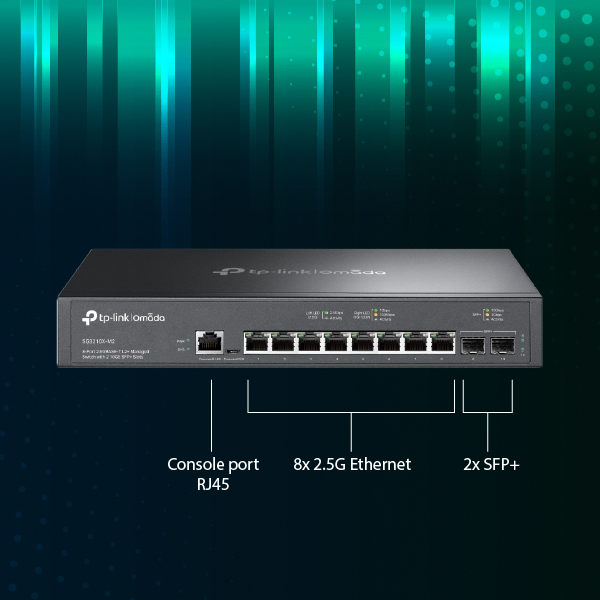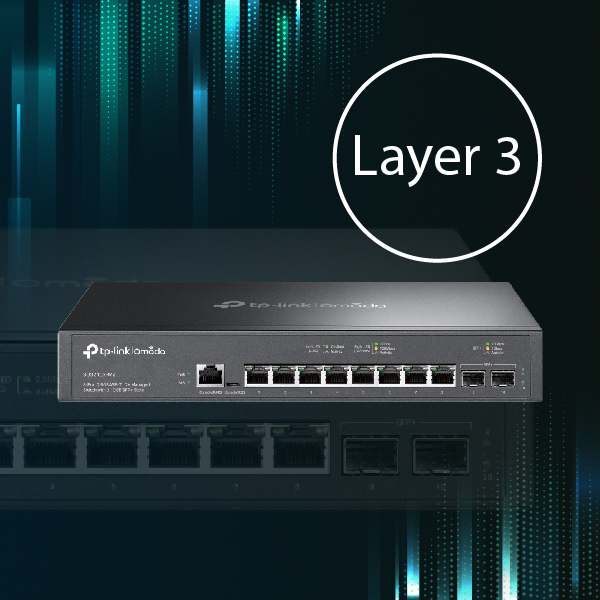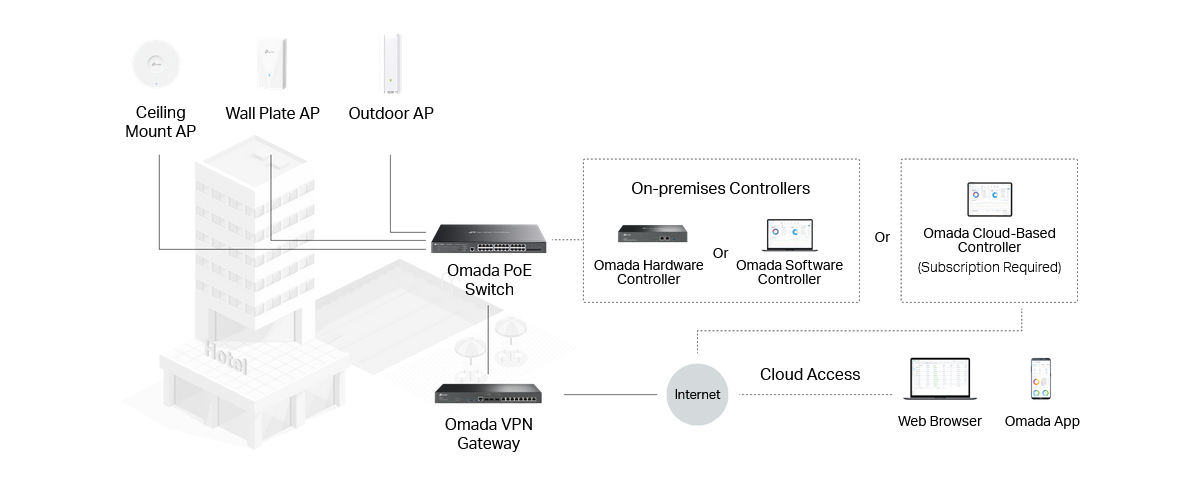-
€

The TP-Link SG3210X-M2 is a managed switch compatible with the Omada system. It features 8 2.5G Ethernet ports and 2 SFP+ (10G) slots, making it suitable for most networks with infrastructure based on 2.5 Gbps throughput. The SFP+ slots allow you to connect via fiber optic cable at 10 Gbps speeds. The switch supports basic Layer 2 management functions and select Layer 3 features, such as static routing, DHCP server, and Proxy ARP. The enclosure is designed for mounting in a 19" rack, with a height of 1U. The switch includes a built-in AC power supply, with a maximum power consumption of 15W. You can manage the SG3210X-M2 through a graphical web interface (standalone mode) or via the Omada system.

8x 2.5G Ethernet, 2x SFP+
The switch is equipped with 8 2.5G Ethernet ports and 2 SFP+ slots, allowing you to build a network infrastructure based on 2.5 Gbps throughput. This provides significantly faster local network speeds compared to standard 1G solutions. The use of SFP+ slots enables 10 Gbps connections with the switch. Additionally, fiber optic cables offer much greater range compared to Ethernet cabling, which is crucial in certain scenarios, such as connecting two office buildings. The device is especially well-suited for networks built on Omada solutions.
Layer 2+ management, AC power supply
The SG3210X-M2 supports basic Layer 2 management functions and fully handles multicast, including IGMP and MLD Snooping. It also supports some Layer 3 features, such as a DHCP server, static routing, proxy ARP, and DHCP Relay. The switch includes advanced security features to protect your network from various attacks. Additionally, it supports special ISP functions (available only in standalone mode, not in the Omada system), such as QinQ, L2TP PPPoE ID Insertion, and IGMP authentication.
The offered product comes with a built-in AC power supply. The input voltage ranges from 100 to 240 V AC, and the appropriate power cable is included in the package. The maximum power consumption is only 15W.


Rack 19" cabinet
The device can be mounted in a 19" rack or placed on a desk/shelf. The package includes rack ears and rubber feet. With a depth of 180 mm, the switch will easily fit into a standard rack.
Omada System Compatibility
You can manage the device using a graphical web interface in standalone mode. In this mode, the switch supports additional features, such as QinQ, L2TP PPPoE ID Insertion, and IGMP authentication. Alternatively, you can manage it through the Omada system, which allows centralized management of multiple access points, switches, and routers to create a unified, extensive wireless network. As you move between different APs, you will be automatically switched without losing your Wi-Fi connection. Omada offers many advanced functions for network configuration and maintenance, making it an ideal solution for professional use in offices, restaurants, schools, universities, and markets.

Specifications
| TP-Link SG3210X-M2 | |
| Hardware features | |
|---|---|
| Interface | 8× 2.5 Gbps RJ45 Ports 2× 10G SFP+ Slots 1× RJ45 Console Port 1× Micro-USB Console Port |
| Fan Quantity | Fanless Design |
| Power Supply | 100-240 V AC~50/60 Hz |
| Dimensions ( W x D x H ) | 294 × 180 × 44 mm (11,6 × 7,1 × 1,7 cali) |
| Mounting | Rack Mountable / Desktop |
| Max Power Consumption | 15,0 W (110V/60Hz) |
| Max Heat Dissipation | 51.18 BTU/h (110 V/60 Hz) |
| Performance | |
| Switching Capacity | 80 Gb/s |
| Packet Forwarding Rate | 59,52 Mp/s |
| MAC Address Table | 16 K |
| Packet Buffer Memory | 12 Mb |
| Jumbo Frame | 9 KB |
| Software features | |
| Quality of Service | 8 priority queues 802.1p CoS/DSCP priority Queue scheduling
Action for Flows
|
| L3 Features | 32 IPv4/IPv6 Interfaces Static Routing
Gratuitous ARP DHCP Server DHCP Relay
|
| L2 and L2+ Features | Link Aggregation
|
| L2 Multicast | IGMP Snooping
MLD Snooping
Multicast Filtering: 256 profiles and 16 entries per profile |
| Advanced Features | Automatic Device Discovery Batch Configuration Batch Firmware Upgrading Intelligent Network Monitoring Abnormal Event Warnings Unified Configuration Reboot Schedule |
| VLAN | VLAN Group
MAC VLAN: 256 Entries Protocol VLAN: Protocol Template 16, Protocol VLAN 16 GVRP VLAN VPN (QinQ)
|
| Access Control List | Time-based ACL MAC ACL
Packet Content ACL IPv6 ACL Policy
|
| Security | IP-MAC-Port Binding
Static/Dynamic Port Security
Port Isolation Secure web management through HTTPS with SSLv3/TLS 1.2 Secure Command Line Interface (CLI) management with SSHv1/SSHv2 IP/Port/MAC based access control |
| IPv6 | IPv6 Dual IPv4/IPv6 Multicast Listener Discovery (MLD) Snooping IPv6 ACL IPv6 Interface Static IPv6 Routing IPv6 neighbor discovery (ND) Path maximum transmission unit (MTU) discovery Internet Control Message Protocol (ICMP) version 6 TCPv6/UDPv6 IPv6 applications
|
| MIBs | MIB II (RFC1213) Interface MIB (RFC2233) Ethernet Interface MIB (RFC1643) Bridge MIB (RFC1493) P/Q-Bridge MIB (RFC2674) RMON MIB (RFC2819) RMON2 MIB (RFC2021) Radius Accounting Client MIB (RFC2620) Radius Authentication Client MIB (RFC2618) Remote Ping, Traceroute MIB (RFC2925) Support TP-Link private MIB |
| Management | |
| Omada App | Yes. Requiring the use of OC300, OC200, Omada Cloud-Based Controller, or Omada Software Controller. |
| Centralized Management | Omada Cloud-Based Controller Omada Hardware Controller (OC300) Omada Hardware Controller (OC200) Omada Software Controller |
| Cloud Access | Yes. Requiring the use of OC300, OC200, Omada Cloud-Based Controller, or Omada Software Controller. |
| Zero-Touch Provisioning | Yes. Requiring the use of Omada Cloud-Based Controller. |
| Management Features | Web-based GUI Command Line Interface (CLI) through the console port, telnet SNMP v1/v2c/v3
DHCP/BOOTP Client 802.1ab LLDP/LLDP-MED DHCP AutoInstall Dual Image, Dual Configuration CPU Monitoring Cable Diagnostics EEE Password Recovery SNTP System Log |
| Others | |
| Package Contents | SG3210X-M2 Switch Power Cord Quick Installation Guide Rackmount Kit Rubber Feet |
| System Requirements | Microsoft® Windows® 98SE, NT, 2000, XP, Vista™ or Windows 7/8/10/11, MAC® OS, NetWare®, UNIX® or Linux. |
| Operating Temperature | 0–50 ? (32–122 ?); |
| Storage Temperature | -40?~70? (-40?~158?) |
| Operating Humidity | 10–90% RH non-condensing |
| Storage Humidity | 5–90% RH non-condensing |






 Polski
Polski English
English Italiano
Italiano Español
Español Čeština
Čeština Српски
Српски Deutsch
Deutsch Ελληνικά
Ελληνικά Slovenský
Slovenský




